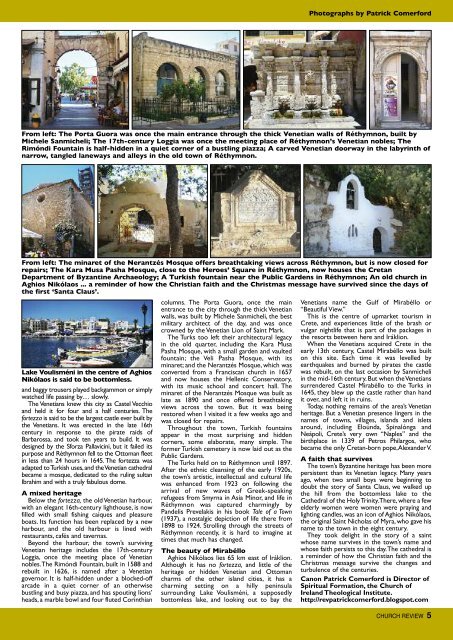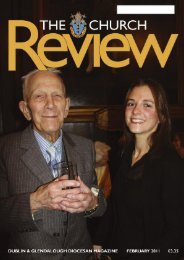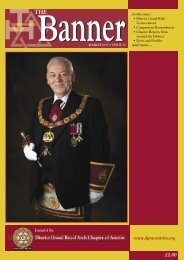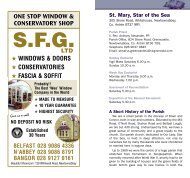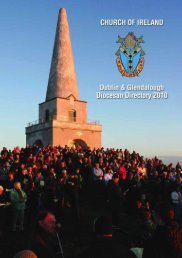You also want an ePaper? Increase the reach of your titles
YUMPU automatically turns print PDFs into web optimized ePapers that Google loves.
Photographs by Patrick Comerford<br />
from left: the Porta Guora was once the main entrance through the thick Venetian walls of réthymnon, built by<br />
Michele sanmicheli; the 17th-century loggia was once the meeting place of réthymnon’s Venetian nobles; the<br />
rimóndi fountain is half-hidden in a quiet corner of a bustling piazza; a carved Venetian doorway in the labyrinth of<br />
narrow, tangled laneways and alleys in the old town of réthymnon.<br />
from left: the minaret of the nerantzés Mosque offers breathtaking views across réthymnon, but is now closed for<br />
repairs; the Kara Musa Pasha Mosque, close to the heroes’ square in réthymnon, now houses the Cretan<br />
department of byzantine archaeology; a turkish fountain near the Public Gardens in réthymnon; an old <strong>church</strong> in<br />
aghios nikólaos ... a reminder of how the Christian faith and the Christmas message have survived since the days of<br />
the first ‘santa Claus’.<br />
lake Voulisméni in the centre of aghios<br />
nikólaos is said to be bottomless.<br />
and baggy trousers played backgammon or simply<br />
watched life passing by… slowly.<br />
The Venetians knew this city as Castel Vecchio<br />
and held it for four and a half centuries. The<br />
fortezza is said to be the largest castle ever built by<br />
the Venetians. It was erected in the late 16th<br />
century in response to the pirate raids of<br />
Barbarossa, and took ten years to build. It was<br />
designed by the Sforza Pallavicini, but it failed its<br />
purpose and Réthymnon fell to the Ottoman fleet<br />
in less than 24 hours in 1645. The fortezza was<br />
adapted to Turkish uses, and the Venetian cathedral<br />
became a mosque, dedicated to the ruling sultan<br />
Ibrahim and with a truly fabulous dome.<br />
a mixed heritage<br />
Below the fortezza, the old Venetian harbour,<br />
with an elegant 16th-century lighthouse, is now<br />
filled with small fishing caiques and pleasure<br />
boats. Its function has been replaced by a new<br />
harbour, and the old harbour is lined with<br />
restaurants, cafés and tavernas.<br />
Beyond the harbour, the town’s surviving<br />
Venetian heritage includes the 17th-century<br />
Loggia, once the meeting place of Venetian<br />
nobles. The Rimóndi Fountain, built in 1588 and<br />
rebuilt in 1626, is named after a Venetian<br />
governor. It is half-hidden under a blocked-off<br />
arcade in a quiet corner of an otherwise<br />
bustling and busy piazza, and has spouting lions’<br />
heads, a marble bowl and four fluted Corinthian<br />
columns. The Porta Guora, once the main<br />
entrance to the city through the thick Venetian<br />
walls, was built by Michele Sanmicheli, the best<br />
military architect of the day, and was once<br />
crowned by the Venetian Lion of Saint Mark.<br />
The Turks too left their architectural legacy<br />
in the old quarter, including the Kara Musa<br />
Pasha Mosque, with a small garden and vaulted<br />
fountain; the Veli Pasha Mosque, with its<br />
minaret; and the Nerantzés Mosque, which was<br />
converted from a Franciscan <strong>church</strong> in 1657<br />
and now houses the Hellenic Conservatory,<br />
with its music school and concert hall. The<br />
minaret of the Nerantzés Mosque was built as<br />
late as 1890 and once offered breathtaking<br />
views across the town. But it was being<br />
restored when I visited it a few weeks ago and<br />
was closed for repairs.<br />
Throughout the town, Turkish fountains<br />
appear in the most surprising and hidden<br />
corners, some elaborate, many simple. The<br />
former Turkish cemetery is now laid out as the<br />
Public Gardens.<br />
The Turks held on to Réthymnon until 1897.<br />
After the ethnic cleansing of the early 1920s,<br />
the town’s artistic, intellectual and cultural life<br />
was enhanced from 1923 on following the<br />
arrival of new waves of Greek-speaking<br />
refugees from Smyrna in Asia Minor, and life in<br />
Réthymnon was captured charmingly by<br />
Pandelis Prevelakis in his book Tale of a Town<br />
(1937), a nostalgic depiction of life there from<br />
1898 to 1924. Strolling through the streets of<br />
Réthymnon recently, it is hard to imagine at<br />
times that much has changed.<br />
the beauty of Mirabéllo<br />
Aghios Nikólaos lies 65 km east of Iráklion.<br />
Although it has no fortezza, and little of the<br />
heritage or hidden Venetian and Ottoman<br />
charms of the other island cities, it has a<br />
charming setting on a hilly peninsula<br />
surrounding Lake Voulisméni, a supposedly<br />
bottomless lake, and looking out to bay the<br />
Venetians name the Gulf of Mirabéllo or<br />
“Beautiful View.”<br />
This is the centre of upmarket tourism in<br />
Crete, and experiences little of the brash or<br />
vulgar nightlife that is part of the packages in<br />
the resorts between here and Iráklion.<br />
When the Venetians acquired Crete in the<br />
early 13th century, Castel Mirabéllo was built<br />
on this site. Each time it was levelled by<br />
earthquakes and burned by pirates the castle<br />
was rebuilt, on the last occasion by Sanmicheli<br />
in the mid-16th century. But when the Venetians<br />
surrendered Castel Mirabéllo to the Turks in<br />
1645, they blew up the castle rather than hand<br />
it over, and left it in ruins.<br />
Today, nothing remains of the area’s Venetian<br />
heritage. But a Venetian presence lingers in the<br />
names of towns, villages, islands and islets<br />
around, including Eloúnda, Spinalónga and<br />
Neápoli, Crete’s very own “Naples” and the<br />
birthplace in 1339 of Petros Philargos, who<br />
became the only Cretan-born pope, Alexander V.<br />
a faith that survives<br />
The town’s Byzantine heritage has been more<br />
persistent than its Venetian legacy. Many years<br />
ago, when two small boys were beginning to<br />
doubt the story of Santa Claus, we walked up<br />
the hill from the bottomless lake to the<br />
Cathedral of the Holy Trinity. There, where a few<br />
elderly women were women were praying and<br />
lighting candles, was an icon of Aghios Nikólaos,<br />
the original Saint Nicholas of Myra, who gave his<br />
name to the town in the eight century.<br />
They took delight in the story of a saint<br />
whose name survives in the town’s name and<br />
whose faith persists to this day. The cathedral is<br />
a reminder of how the Christian faith and the<br />
Christmas message survive the changes and<br />
turbulence of the centuries.<br />
Canon Patrick Comerford is Director of<br />
Spiritual Formation, the Church of<br />
Ireland Theological Institute.<br />
http://revpatrickcomerford.blogspot.com<br />
CHurCH rEviEw 5


